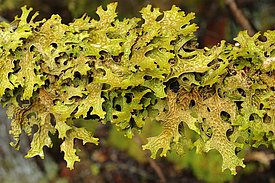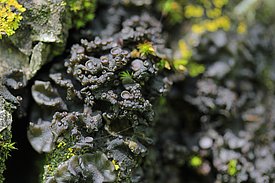

A lichen is a symbiotic organism, i.e. one that is made up of two different species that both benefit from each other. The basis of the lichen organism is a fungus, the mycobiont. In most cases this is a ascomycete, in rarer cases it is a basidiomycete. The fungus houses a photobiont, which carries out photosynthesis and provides the fungus with nutrients such as sugar in exchange for the protection it is given against eating, UV and drying damage. The photobiont is either a green alga or a cyanobacterium. This combination of beneficial properties of two organisms allows lichens to colonise habitats that are not habitable to other organisms such as plants.
Lichens exist in various shapes. They are usually morphologically divided into the groups crustose lichens, fruticous lichens and foliose lichens. Some species reproduce sexually by forming fruiting bodies from which spores are released into the air. Other species limit their reproduction to asexual methods, e.g. in the form of tiny pieces of fungal and algae tissue that detach themselves from the body of the lichen and move to new places with the help of wind, water or animals.
Lichens grow on all kinds of surfaces. The most common substrates are bark, wood, soil and rock. Sometimes the lichens do not sit directly on the substrate, but on a layer of moss that covers the substrate. Apart from these common substrates, lichens also grow on leaves, needles, stone walls, roof tiles, metal pipes, car roofs, electric fences and many other man-made things.
![Cetraria nivalis b [Translate to Englisch:] *Cetraria nivalis* ist eine bodenbewohnende Strauchflechte. Bild: Jean-Claude Mermilliod](/fileadmin/_processed_/4/b/csm_Cetraria_nivalis_b_4df7d7d7fe.jpg)
![Placynthium nigrum c [Translate to Englisch:] *Placynthium nigrum* ist eine steinbewohnende Krustenflechte, die Cyanobakterien als Photobionten hat. Sie weist die für Cyanoflechten typische dunkle Färbung auf. Bild: Jean-Claude Mermilliod](/fileadmin/_processed_/c/6/csm_Placynthium_nigrum_c_df27ee2cff.jpg)
![Xanthoria parietina [Translate to Englisch:] Die Wand-Gelbflechte *Xanthoria parietina* ist eine Blattflechte, die vor allem auf Rinde wächst. Im Bild ist unterhalb der Wand-Gelbflechte ausserdem eine kleine Ziegen-Schwielenflechte *Physcia aipolia* zu sehen. Bild: Jean-Claude Mermilliod](/fileadmin/_processed_/a/3/csm_Xanthoria_parietina_69e1288c29.jpg)